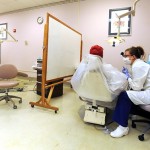Dental appointment cancellations are a major concern of most dental offices today. Cancelled appointments lead to wasted time and money. According to Dental-tribune.com even when the economy is doing well revenue losses can range from $40,000 to $60,000 per year. This value doesn’t include the potential money that could be earned if the patient did come to the appointment, and further treatments and procedures were needed. Often practice teams place the blame of failed appointments on the patients—their lack of respect for the dentist’s time, their lack of urgency of getting the dentistry done, and just plain rudeness. Although some of the responsibility rests with patients, a significant contributor to the problem is the dental team and the lack of training on communications skills that prevent failed appointments and how to effectively handle and “turn around†cancellation calls.  Minimizing cancellations can be done in numerous ways.
Instructions
- Create a policy. Establishing a cancellation policy and making it known to patients will lead to fewer cancellations. Making patients aware of the policy, especially new patients, is an important part in minimizing cancellations, according to Dental-tribune.com. Appointments should include the complete date, the starting time, and the length of the appointment.
- Schedule a realistic and feasible number of appointments. Overbooking results from cancellations and patients who do not show up. Although a patient may need several follow-up procedures and appointments, don’t book them all at the same time.
-
Confirm appointments at least 48 hours before the scheduled time. Confirmation calls are necessary to minimize the number of cancellations. Speaking directly to a patient is best so that messages are not missed. Alternate ways of reaching the patient are also a good way to minimize cancellations. Emails, texts, and reminder appointment postcards can also be sent to ensure that the patient has not forgotten the appointment date and time.
- Incorporate a scheduling system that is computerized. A computerized system can help fill cancellations quickly, as well as help keep track of the entire schedule. Computer scheduling programs can include lists of patients that can come in sooner, and can find patients to fill gaps in the schedule. These programs also allow printing of the schedule for each room.
- Fill in cancellations quickly. If a patient cancels in advance, the spot should be filled quickly so it is not forgotten about. Computer systems help with completing this. Calls should be made to patients that can possibly make the cancellation time.
- The New Patient Telephone Call. The best communicator in the office needs to be the person who is scheduling that first appointment because that is the first impression the patient receives. The way the telephone is answered and how the appointment is set determines the patient’s perception of the financial, scheduling, and care philosophy of the practice. It should be communicated that the dentist’s time is valuable and that the patient has responsibilities, including financial responsibilities. The one thing that should never, ever be said is, “If you need to cancel or reschedule, give us a call.â€
- Confirmation Techniques. When we use words like “confirm†and “remind†and request patients to call us back, we make it easy for them to call and cancel. Instead, when phoning patients, set the expectation that they will be at their appointment and don’t use any language that indicates that they have the option of canceling. This works equally as well when talking to them directly or leaving a message. A sample script could read: “Good afternoon, Mrs. Jones. This is a courtesy call to let you know that you are on Dr. Smith’s schedule for Tuesday at 3:00. It looks like we are going to get more rain on Tuesday, so remember your umbrella! We are looking forward to seeing you again.â€
- Printed Materials. Sometimes the wording on reminder cards and brochures sets the stage for cancellations. If a dentist puts in print that 24 hours notification is required for a cancellation, it effectively tells patients that it is acceptable to cancel and gives them an open invitation to do so. When sending out reminder or confirmation cards, they should simply tell the patient that they are on the dentist’s schedule and they are expected in the office on that date and time.
-
Ensure “Buy Inâ€. When setting the appointment, instead of asking patients if they have any questions, which only requires a “yes†or “no†answer, ask open-ended questions that will engage the patient in conversation, providing the opportunity to verify that they have “bought into†treatment. Ask questions such as “What questions can we answer for you about your financial responsibility at the next appointment?†or “What questions can we answer for you about the procedures we just discussed?†These types of questions promote conversation, which helps to verify that there are no concerns or issues that might lead to cancellations.
Tips & Warnings
- It is easy for patients to lose track of numerous appointments, and booking several appointments at a time does not ensure that the patient will not cancel.
- Although many dental offices have a cancellation fee, it may make patients change dentists if they are charged.


